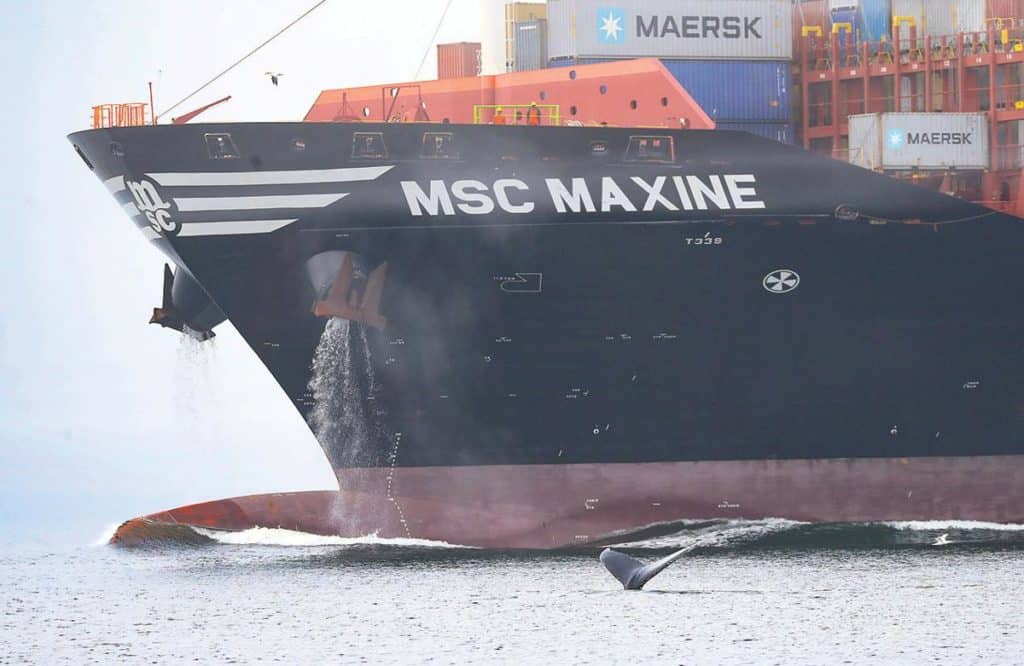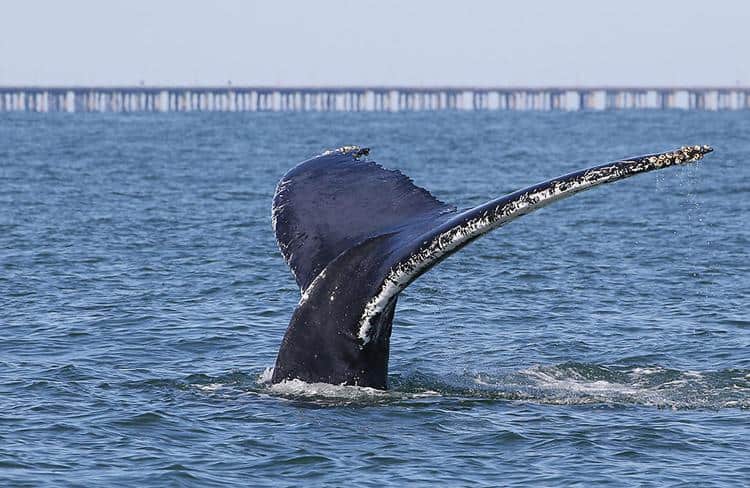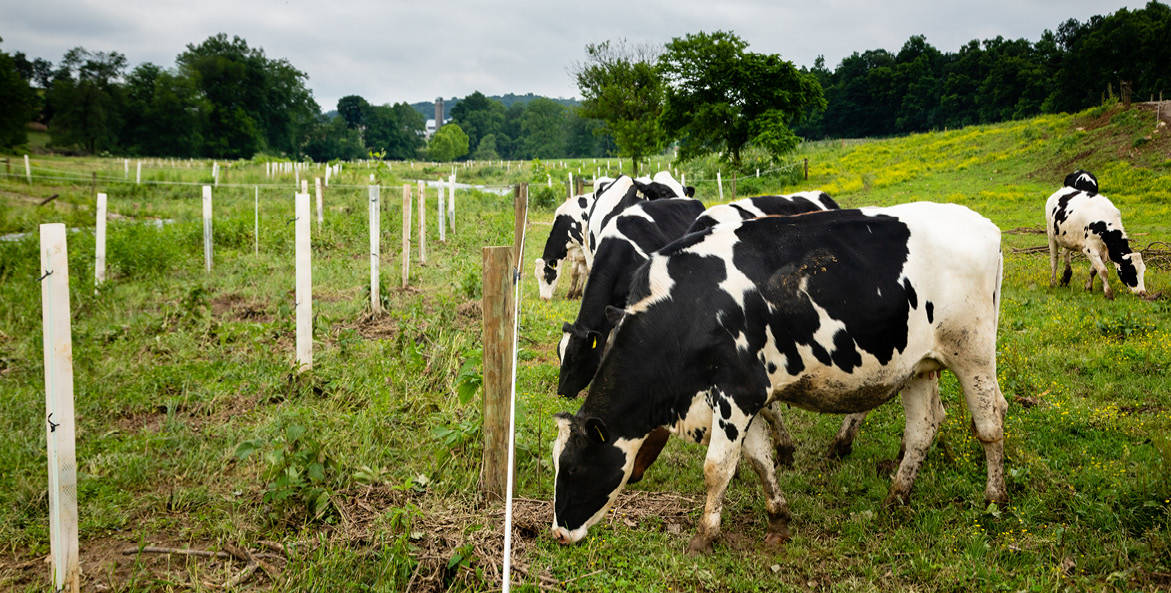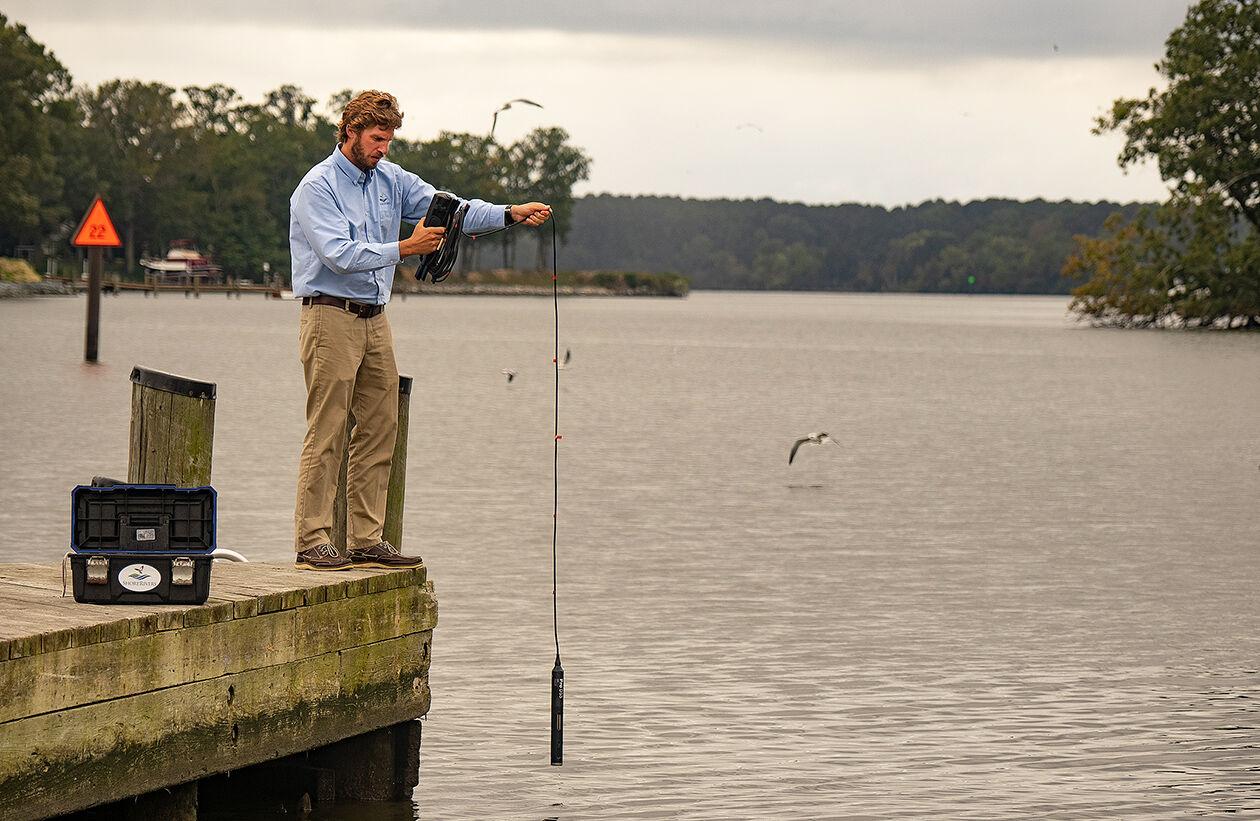By Jeremy Cox, Bay Journal News Service
He was known by a number in life. In death, he became a statistic.
Attracted by a relative abundance of fish, growing numbers of humpback whales spend the winter in the waters where the Chesapeake Bay empties into the Atlantic Ocean. No. 166675 was one of them.
Researchers tracked the young male with a satellite tag for 10 days in January 2017 as he dodged huge vessels in one of the busiest shipping lanes on the East Coast. The next month, the whale’s body washed ashore on Virginia Beach. A necropsy confirmed the scientists’ fears: He had been struck by a large ship.
After six years of monitoring humpbacks’ movements in the Hampton Roads region, the team conducting the Navy-funded study has published its first peer-reviewed paper. It shows that many more humpbacks are at risk from ship strikes and suggests that authorities may need to take more actions to protect them.
Between December 2015 and February 2017, researchers tagged and followed 35 humpbacks at the mouth of the Bay. Their study, published in the journal Frontiers in Marine Science in March, reveals that those whales typically spent more than a quarter of their time inside one of the region’s busy shipping channels.
“They tend to be relatively slow and spend time at the surface, and they tend to congregate where big ships are trying to pass through,” said Joel Bell, a Norfolk-based senior marine resources specialist with the Naval Facilities Engineering Command. Ship strikes, he added, “are just an unfortunate consequence.”
Humpbacks in crisis
The study is part of a wider research effort scrambling to explain why dozens of humpback whales have mysteriously turned up dead along the East Coast from Maine to Florida since 2016. The deaths have prompted the National Oceanic and Atmospheric Administration to label the phenomenon an “unusual mortality event.”
The agency has assembled a scientific workgroup to study the 123 whale fatalities documented so far. Early results suggest that about half of the known causes of death are tied to boat-related mishaps, such as ship strikes and fishing-gear entanglement.
Of the 13 states where dead humpbacks have been found, Virginia has recorded the most after New York, with 23, according to NOAA.
Ship traffic is heavy at the entrance to the Chesapeake. Much of it is generated by the Port of Virginia, the sixth-busiest U.S. container port, and Naval Station Norfolk, the world’s largest naval installation. But the area also is teeming with recreational boaters and commercial fishing vessels.
Humpback whales were once rarely spotted in the Bay’s waters. Most of the North Atlantic population of humpbacks migrates southward in the winter from Arctic waters to breeding grounds in the Caribbean Sea. But for nearly 30 years, marine scientists have detected an increasing number of young males stopping short in waters between New Jersey and North Carolina, with many clustered at the mouth of the Chesapeake Bay.
Those tagged during the Navy’s study have roamed widely during their months-long stay, Bell said. Some veer well offshore. Others venture as far west as the Hampton Roads Bridge Tunnel. But when they’re ready to eat, they follow their prey — a small, oily fish called menhaden — to the Bay’s shipping channels.
Tracking the whales
A Navy spokesman said each of its vessels has specially trained spotters onboard to keep a lookout for whales, including humpbacks, whenever they’re in the Chesapeake shipping channels.

The Endangered Species Act and Marine Mammal Protection Act require the Navy to also monitor the impacts that its ships have on sea life. A decade ago, the Navy hired the consulting firm HDR to track the whales, which centered on creating a photo database of individual whales.
That evidence has shown that nearly 10% of the more than 100 whales identified in and around the Bay had scars or other wounds consistent with propeller injuries or ship strikes. “While it is impossible to conclude if these injuries occurred outside of the study area,” the authors of the new study wrote, “the evidence from this study highlights different instances where humpback whales were observed in the study area without injuries and re-sighted within the same season with vessel-related injuries.”
As questions mounted about a possible link between the Navy’s activities and whale deaths, the military ramped up its monitoring. Since 2014, it has spent more than $1.6 million to supplement the annual photographic surveys with satellite tags, giving a clearer picture of humpback whale movements.
The HDR team uses a modified air rifle to fire two darts simultaneously into a whale’s dorsal fin or just below it. “We don’t really like to miss a shot because they cost about $5,000 to $8,000 each, and they sink,” Bell said.
The darts provide the anchoring for a golf ball-size transmitter that sends continuous location signals to a satellite. After anywhere from a few days to a few weeks, the tag falls off.
Over three winters, the investigators found that all 35 whales they tagged traversed a shipping channel at least once. They also swam freely, covering an average of 40 miles per day. The biggest traveler was a male that trekked more than 300 miles to just south of Massachusetts.
On several occasions, the researchers captured photos of ships passing dangerously close to whales as they breached.
“We’ve been out there and seen these ships passing super-close to these animals while they’re diving down and foraging,” said Jessica Aschettino, HDR’s project manager. “It is pretty scary when you see those close calls.”
Protections recommended
The study recommends that an existing seasonal boat speed zone at the Bay’s mouth be expanded to help shield humpbacks from ship strikes.
From November to April, all vessels measuring 65 feet or longer are required to stay below 10 knots. The “Seasonal Management Area” was put in place there and elsewhere along the East Coast to protect endangered right whales. In the Hampton Roads region, it stretches from the tip of the Eastern Shore to Cape Henry and as far out to sea as 22 miles.
The speed zone should be extended farther into the Bay and farther offshore, Aschettino and her co-authors say.
Whale 166675 was the only animal tagged during the HDR study whose death could be confirmed. The whale had a cut so deep on its back that it exposed internal organs.
A ship propeller was the likely cause, the researchers wrote.
Read this article in its entirety at bayjournal.com.




